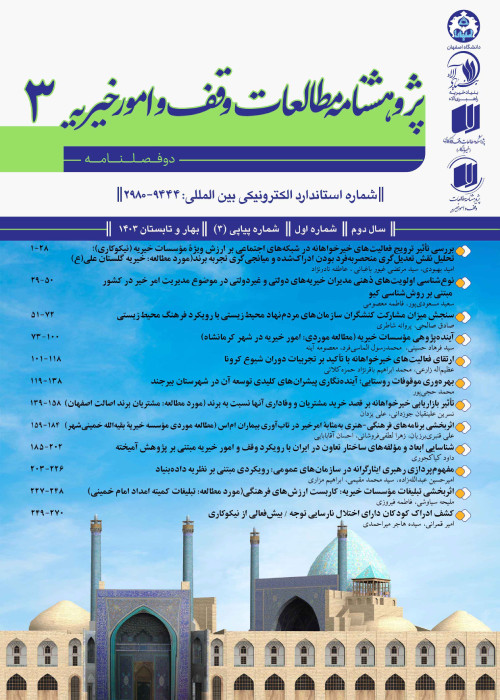Identifying the Level of Participation of Activists of Environmental NGOs with the Approach of Environmental Culture
Environmental problems have created crises in the world, including Iran, and the risk of irreversibility of its consequences has recently increased. Many of these issues stem from increased energy consumption, population growth, and industrialization. To solve environmental issues and create compatibility between development plans and the environment, the participation of all environmental groups is necessary. Among these groups, there are non-governmental organizations, and examining them on the one hand indicates their positive role and function, and on the other hand, shows that they are facing challenges and obstacles. To increase the efficiency of NGOs, it is necessary to recognize these challenges and make the necessary planning to eliminate, reduce, or transform them into new opportunities. To deal with environmental crises, we can focus on participation as one of the important primary tools. Also, the gradual reduction of decentralization by using NGOs to attract people's participation and create social changes in the field of environment shows the efficiency, effectiveness, and value of their performance and takes a step towards environmental development. Considering that environmental NGOs can be a platform for changing environmental behaviors in society; the goal of the researchers in this article is to measure the participation of environmental NGO activists and investigate the impact of environmental culture on the participation of environmental NGO members. Based on this, the main question of the research is what effect did the environmental culture (knowledge, value, attitude, and norms) have on the environmental participation of NGO members and is there a correlation between these variables?
A survey research method was used and the data collection technique was an online questionnaire. The statistical population of the research was all the members of the registered environmental NGOs in Tehran, and 376 people were selected as a statistical sample using the relative random sampling method. Data analysis was done using SPSS software. To check the reliability of the questionnaire, Cronbach's alpha coefficients were used, which were acceptable for all variables. Also, the validity of the questionnaire was measured through face validity using the opinion of specialists and experts in the field of study, and the definitions of the concepts and the questionnaire were approved by the judges. The validity of the structure was also measured based on the confirmatory factor analysis test. The value of KMO = 0.789 indicates the ability of the data to apply the factor analysis technique to them, and the significance level of Bartlett's test (0.000) indicates the ability to generalize the factor analysis to the entire population. The factor load also indicates a high correlation between the questions and the factor. The results of this test indicate that the construct validity of the research variables has been confirmed.
Based on the results of descriptive statistics, 61% of the respondents were male, 39% were female, and their average age was 44 years. About 90% of the respondents reported a bachelor's degree or higher. According to the findings, about 100 percent of the respondents had average and higher personal norms, knowledge, and environmental attitude.
In addition, the environmental values of 98.4 percent of respondents were reported to be medium and higher. The environmental norms of more than half of the respondents were at an average level or higher. Also, equivalent to 65.4 percent of the respondents have expressed their collective norms at an average level or higher.
The findings of inferential statistics showed that there is a significant, positive, and direct correlation between the variables of knowledge, attitude, value, individual norms, collective norms, environmental norms, and the total dimensions of environmental culture with environmental participation and that there is no correlation between environmental norms and environmental participation. Multivariate regression analysis was done to predict changes in the dependent variable (environmental participation) by a set of independent variables. According to the regression model, the correlation coefficient of independent research variables to explain participation is equal to 0.58. The proportion of the variance of the participation variable explained by the research variables is 33.7%. That is, 33.7% of the changes in the environmental participation variable are covered by independent variables. The beta coefficient indicates the influence of independent variables on participation. In addition, the research findings indicated a high level of environmental culture among the majority of respondents (97/3). Also, a positive, direct, and significant correlation was reported between environmental culture and the participation of NGO members.
The results of the research showed that NGOs are interested in participation, mostly in environmental protection and symbolic activities. This is due to their greater appearance in society and social impact, and causes more visibility and participation, strengthens the relationship with the local community and mid-level planners, and increases their bargaining power. According to the level of participation in NGOs and planning of members to prevent damage to nature, the results confirm and align with the new ecological paradigm of public sympathy towards other species, action to prevent danger to humans, nature, and participation. Also, because the members of NGOs consider themselves committed to environmental protection and have environmentalist behaviors and participation, there is an alignment with the value-belief-norm theory. The members of NGOs are the basis for changes in environmental behavior in the society. Although their activity and participation are subject to structural and social limitations; they are trying to improve the culture of participation and change in people and influence the construction of society. Finally, it can be said that in the interaction between culture and society, what guides people's behavior and participation, is culture, and by considering cultural dimensions or changes in them, it is possible to change the direction of people's actions and their participation in the direction of sustainable development.
- حق عضویت دریافتی صرف حمایت از نشریات عضو و نگهداری، تکمیل و توسعه مگیران میشود.
- پرداخت حق اشتراک و دانلود مقالات اجازه بازنشر آن در سایر رسانههای چاپی و دیجیتال را به کاربر نمیدهد.



